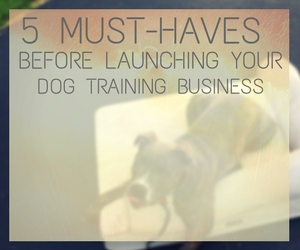![Guest Post – What It’s Like to Start a Dog Training Business from Scratch]()
by Ines | Jan 10, 2017 | Business
This is a guest post by an up and coming positive gun dog trainer in California. In this post, he talks about what it’s like to start up a dog training business from the ground up. Learn about how he got started and the opportunities he pursued to help the transition.
 Hello! My name is Zane Brown and I own and run Reliable Retrievers LLC in Fresno, California. I opened my dog training business in late 2016. I’m here to share my story of what lead me to open my own dog training business and what it was like along the way.
Hello! My name is Zane Brown and I own and run Reliable Retrievers LLC in Fresno, California. I opened my dog training business in late 2016. I’m here to share my story of what lead me to open my own dog training business and what it was like along the way.
The start of my journey to become a dog trainer happened at a time when I really didn’t realize how my life’s direction would change, or even what the significance was at the time. In 2014, a Labrador puppy came into my life that would change it all for me. This young pup and I had such a unique bond. He inspired me to take a positive reinforcement obedience class, and before I knew it, I was hooked. I was fascinated with what you could achieve with this revolutionary new method.
 Now, on to the events that helped me to realize my dream and take the first step. It all started in early 2016 when I got an email from Thomas Aaron of Fetchmasters LLC in Denver, Colorado. I had been emailing back and forth with Tom for several months about positive gun dog training. One of the first things that we had talked about was that he held workshops every year but he wasn’t sure when the next one would be. I kept eagerly checking his website every few weeks, but never noticed any update. Then, one day, Tom emails me and tells me that the workshop is on for this coming May, and that there might even be a scholarship available, if I acted now. I quickly emailed Tom back and said I was interested in attending!
Now, on to the events that helped me to realize my dream and take the first step. It all started in early 2016 when I got an email from Thomas Aaron of Fetchmasters LLC in Denver, Colorado. I had been emailing back and forth with Tom for several months about positive gun dog training. One of the first things that we had talked about was that he held workshops every year but he wasn’t sure when the next one would be. I kept eagerly checking his website every few weeks, but never noticed any update. Then, one day, Tom emails me and tells me that the workshop is on for this coming May, and that there might even be a scholarship available, if I acted now. I quickly emailed Tom back and said I was interested in attending!
This was what I had been waiting and hoping for, I couldn’t let this opportunity slip away. As excited as I was, I was also a little nervous because of the monetary commitment: there was the hotel (with a dog no less!), 3 meals a day, half day boarding for my dog (while we attended the lecture part) and finally the gas I would have to spend for the 9 days. However, this is what I wanted to do and positive training was my passion, so I took the leap of faith, and I haven’t looked back since. I decided that the pros would vastly outweigh the cons in taking this chance because I would get to learn a friendlier way to train gun dogs, something that was of a very personal significance to me. I grew up around the traditional way of training gun dogs, yet I had always wanted to find a friendlier, more positive way to train them. Something about the nature of positive reinforcement techniques just resonates with who I am as a person.
The 9 days were incredible. We learned so much about the fundamentals of dog training, had some fun times working in the field, and made some lasting friendships along the way.

Starting Up My Dog Training Business
When I returned home, I wasn’t really sure where to start, but I knew I wanted to get the ball rolling and start working with dogs. It was a little nerve-wracking, but I decided I wouldn’t that let stop me. To be honest, I wasn’t sure when my next day paycheck would come in, and that really terrified me because I had always been rather conservative with money.
Well, the ball took a while to “get rolling.” For my specific venue of dog training, there were certain things I would need; the main one being a safe and legal location to discharge firearms. One of the biggest challenges has been looking for land to lease that would accommodate these needs. Another major challenge has been self-confidence, which I believe goes hand in hand with the fear and uncertainty of whether or not your business is going to thrive and succeed. For a while there, I was unsure of my abilities to train dogs, despite all I had learned.
One of the things that I discovered in starting my own business is that there is a factor of uncertainty to this whole process. This is not meant to scare anyone reading this. It’s just a reality that I want to share so that you understand. You can’t let the uncertainty stop you if you want to work for yourself. With that said, I think that it is important to realize that you can ask for help, and that there is nothing wrong with that. In starting your own business, it is definitely a bonus to have support and someone who has been through the process and can guide you. If you’re starting your own business and you’re stuck, there is help and support out there. Please feel free to reach out to me.
Recommended Reading: Why You Should Do Some Market Research Before Starting Your Dog Training Business
Business Tips for Dog Trainers
Perhaps one of the most significant events in my journey so far was when I found The Modern Dog Trainer and Ines McNeil. A friend of mine invited me to join a Facebook group all about startup tips for dog trainers. Up until this point, I lacked a little bit of focus on getting things started, but with the tips from Ines, that cleared up quickly. I think the major factor that helped clarify the process and gain a good sense of direction was The Modern Dog Trainer business course. One of the main ways that it helped me was to know how to appropriately protect myself legally. It’s a topic that no one wants to talk about, but it’s a necessity if you’re going to be a dog trainer. Another way is it helped me with knowing how to build my website and how to market myself. These things are essential in today’s world. You have to have an online presence and you have to get your name out there.
Getting My First Client
 I will just share one last quick story. I was really nervous about who my first client was going to be. However, one day, a few days ago in fact, I decided to grab the bull by the horns and just go for it. A prospective client emailed me about my services and after talking with a trainer friend of mine I felt a surge of confidence and responded to the client. During this conversation, I realized that I had an idea about where exactly I wanted to start with this client in the training process. It was also the fact that he came to me not just for dog training, but also for advice on hunting itself. It hit me that I had been hunting since I was about fifteen and I knew a lot about it. I have a lot of hunting experience, and done different types of hunting (upland, waterfowl). These are the things that gave me this boost in confidence.
I will just share one last quick story. I was really nervous about who my first client was going to be. However, one day, a few days ago in fact, I decided to grab the bull by the horns and just go for it. A prospective client emailed me about my services and after talking with a trainer friend of mine I felt a surge of confidence and responded to the client. During this conversation, I realized that I had an idea about where exactly I wanted to start with this client in the training process. It was also the fact that he came to me not just for dog training, but also for advice on hunting itself. It hit me that I had been hunting since I was about fifteen and I knew a lot about it. I have a lot of hunting experience, and done different types of hunting (upland, waterfowl). These are the things that gave me this boost in confidence.
I also remembered words from another trainer-friend of mine, “You have to start somewhere.” So, that is my story, or at least the beginning of it. It began with the unique connection between a dog and his human, and it has grown into so much more that. However, I believe it’s important to remember where it all started, whom it started with, and remember the humble beginnings.
My Future Goals
One of my biggest goals is to spread awareness of positive reinforcement gun dog training in California. In addition to offering training services, I want to start an educational division of my business where I offer workshops and seminars to demonstrate the power of positive methods on dogs.
I also want to affect change on a national level, starting with the Boy Scouts of America organization. As an Eagle Scout, I know firsthand just how important this organization is in the lives of young people. There are a lot of critical skills that this organization teaches. I wish to aid in that effort by discussing with them and presenting them with a science-based, proven, positive reinforcement methods for their Dog Care merit badge requirements. It is my hope that positive reinforcement training continues to gain traction and a foothold in the world of hunting dogs.
 Looking into starting your own dog training business? Grab our free eBook, “10 Common Mistakes New Dog Trainers Make With Their Businesses.”
Looking into starting your own dog training business? Grab our free eBook, “10 Common Mistakes New Dog Trainers Make With Their Businesses.”
If you’re thinking about starting your own dog training business, take advantage of this free eBook to avoid some detrimental mistakes that many dog trainers make.
Are you spending your time on the right tasks to grow your business? Are you worried about making continuous income throughout the year? Will your business be sustainable for years to come? Prepare yourself with the help of this eBook!
Get the eBook
![Guest Post – What It’s Like to Start a Dog Training Business from Scratch]()
by Ines | Dec 27, 2016 | Marketing
My affiliate disclaimer applies to this post.
 It’s not a secret that dog trainers spend a lot of time on social media. Why not optimize your time on Facebook to grow your business?
It’s not a secret that dog trainers spend a lot of time on social media. Why not optimize your time on Facebook to grow your business?
Facebook is a powerful platform for sharing your message and reaching new, potential clients. These strategies can help you grow your audience and make the most of your time on social media to turn “Likes” into customers!
Set a Clear Goal for Each Post
Do you want people to simply like it and move on? Do you want viewers to read the article and sign up for something? Is the article on your website set up with a email sign up form to capture the emails of people that are interested in what you have to offer?
These are simple inbound marketing questions that you should ask anytime you post on social media. What action do you want the reader to take? Posting for the sake of posting means you’re missing the whole point of social media for marketing your business.
Use action words to encourage interactions like likes, comments, or shares. Ask thought-provoking questions to get readers to open the link and read your articles. Get creative, but make sure every post will contribute to your overall goals to grow your dog training business.
Related: Smart Facebook Marketing Strategies eBook by Brittany Ann
Use a Tracking Pixel on Your Website
By copying and pasting the Facebook tracking pixel code to your website, you’ll be able to target people who have visited your website with any future advertising or promotions you want to run. People who visit your website could be your current customers AND potential clients that haven’t committed to hiring a dog trainer yet.
You can use the Facebook Pixel to stay in touch with these people over a few weeks and stay top-of-mind for whenever they’re ready to hire a dog trainer.
Promote Posts Strategically
Facebook’s always urging you to (financially) promote your posts so that you can reach a bigger audience. Promoting posts isn’t a bad idea, but you have to do it at the right time. Ideally, you should wait until a post already has some likes, comments, or shares because your money will go reach a bigger audience and when people see it being promoted it looks like it’s already popular. Promoting a post that hasn’t already gotten a few likes or comments won’t look very enticing to a larger audience.
Even More Facebook Marketing Tips for Dog Trainers

Looking to grow your Facebook page quickly and increase your reach to fill up your dog training appointment schedule? You’ll definitely want to check out the eBook, “Strategies Worth Sharing” on Facebook marketing by Brittany Ann.
“With over 70 pages of no-fluff, no-nonsense strategy in the book alone, these are the tricks you’ve been missing!”
Brittany Ann explains many different techniques you can use to improve your Facebook page’s performance to grow your Facebook audience and generate new clients from your use of social media.
When leveraged correctly, Facebook can be just as powerful as Google for growing your client base. Unfortunately, many dog trainers waste a lot of money promoting posts that won’t give them a return on their investment. With this eBook, you can be confident you’re spending time on tactics that will actually make a difference to your dog training business’ bottom line.
See a detailed outline of this eBook and order your copy here. It’s extremely affordable ($20!) considering the potential reach and growth Facebook could provide your business in 2017!
Dog Training Business Tips
Receive valuable dog training business tips and resources right in your inbox! Subscribe to The Modern Dog Trainer now by submitting your name and email below. Don’t forget to let us know what you want to learn more about!
[mc4wp_form id=”2494″]
![Guest Post – What It’s Like to Start a Dog Training Business from Scratch]()
by Ines | Dec 19, 2016 | Business
 When you’re first starting out on your own as a dog trainer you might not have all the right forms or documents created until you discover you need them. In this article, I’m going to point out some important and necessary documents you should have ready before you start taking on new clients.
When you’re first starting out on your own as a dog trainer you might not have all the right forms or documents created until you discover you need them. In this article, I’m going to point out some important and necessary documents you should have ready before you start taking on new clients.
1. In-Depth New Client Intake Form
Intake forms ensure you’re aware of the entire situation before taking on a new client. Having an intake form that dives into even the most minor details can help you create a more detailed training program or behavior modification program and may bring out some details about the dog that the owner may not find relevant to their training goals. As the professional, the more details you gather the better you can perform your job.
By gathering as much information as possible before you begin training, you can make the call as to what details about the situation or about the dog are relevant or irrelevant to the owner’s training goals.
Your new client intake form should ask questions about the dog’s diet, the dog’s past behavior history, the owner’s lifestyle, the dog’s medical history, and much more. Asking questions not only gives you a better understanding of the context of the dog’s behavior, but you just might spur some old memories from the client that may be unexpectedly relevant to the dog’s behavior changes or issues.
Related: 10 Customizable Dog Training Business Templates
2. New Client Welcome Packet
A new client welcome packet is a handout that explains what it’s like to work with a dog trainer, with your business, sets expectations, and sets up the (human) client to be successful as much as it does the dog. For many of your new clients, this will be their first time working with a dog trainer.
What can they expect from you with regards to instructions, communication, and follow-up? What is expected of them? What do you need from them to do your job well and reach their training goals?
A new client welcome packet explains all of this in detail so that they can be comfortable and aren’t left with a lot of questions. Giving your new clients a welcome packet helps you look professional and they’ll feel supported right from the start. Professionalism and customer experience are some of the best ways to differentiate yourself from your competition.
3. Client Lesson Overview Handout
Most trainers will follow up lessons with an email that briefly overviews what was taught in the lesson or they jot down notes on a blank piece of paper during the lesson. This can leave the client confused and important pieces of training information could be left out of the notes.
Instead, I recommend that you have a worksheet or handout that you fill out as you’re working with your clients. This kind of handout can include specific spaces to list management requirements, steps for breaking down complex behaviors and lists of rewards that that specific dog enjoys and will work for. This makes your notes easy for the client to read. Alternatively, you could even have the client fill this out during your lesson. This sets you and your (human) client up for success.
4. Specific Behavior Modification Assessment Forms
Taking on clients with leash reactivity, resource guarding, or separation anxiety? In addition to an in-depth intake form, you should have separate forms for each behavior issue that will require behavior modification. You shouldn’t ask clients with dogs with leash reactivity issues questions about separation anxiety and vice versa. (Unless, of course, their dog suffers from both.) Creating extra handouts centered around specific behavior issues will allow you to gather the right, detailed information from clients with specific challenges.
5. Follow Up Emails
Speedy correspondence is important for landing new clients. Making sure you have some emails you can quickly pull from and edit based on the prospect’s inquiry will save you time. Having a prepared email ready means you’ll also be less likely to forget critical information you’d want your potential client to know.
 Does this mean you copy/paste your email response without any kind of customization? No. You’ll still want to respond to any specific questions the prospect had or tell them that you understand their situation to start building a rapport with them, but having a template to pull from will make it easier for you to respond in a timely manner with all the right information they’ll need to begin working with you.
Does this mean you copy/paste your email response without any kind of customization? No. You’ll still want to respond to any specific questions the prospect had or tell them that you understand their situation to start building a rapport with them, but having a template to pull from will make it easier for you to respond in a timely manner with all the right information they’ll need to begin working with you.
I recommend you check out my New Dog Training Business Template Bundle that includes these five templates and five additional templates to give your business a major jump start. Each template can be completely customized to suit your branding and messaging. These templates and forms include the most relevant and important questions that the best professionals in our industry use all the time.
View The Template Bundle
Dog Training Business Tips
Receive valuable dog training business tips and resources right in your inbox! Subscribe to The Modern Dog Trainer now by submitting your name and email below. Don’t forget to let us know what you want to learn more about!
[mc4wp_form id=”2494″]
![Guest Post – What It’s Like to Start a Dog Training Business from Scratch]()
by Ines | Dec 4, 2016 | Podcast
Molly Sumridge came on the show today to discuss how compassion fatigue is affecting thousands of pet professionals who give their heart and soul into their profession and forget to take care of themselves. She explains how it’s different than burn out and how it may be happening without you even knowing.
If you enjoy this podcast, please subscribe to The Modern Dog Trainer Podcast on SoundCloud or iTunes. Follow The Modern Dog Trainer Blog on Twitter at @ModernTrainer, on Facebook at The Modern Dog Trainer Blog Page, and on Instagram at @TheModernDogTrainerBlog. We love hearing from our listeners!
Please leave us a review on iTunes to help support our podcast! Every review helps boost our podcast in the ranks of iTunes.
Show Notes
“Compassion Fatigue is a state experienced by those helping people or animals in distress; it is an extreme state of tension and preoccupation with the suffering of those being helped to the degree that it can create a secondary traumatic stress for the helper.” Dr. Charles Figley
 Tips for preventing compassion fatigue:
Tips for preventing compassion fatigue:
- Mindfulness training
- Resilience training
- Positive thinking
- Gratitude
- Meditation
- Breathing
What to do if you’re struggling right now:
- Suicide Hotline 1-800-273-8255
Be proactive and help yourself online:
Dog Training Business Tips
Receive valuable dog training business tips and resources right in your inbox! Subscribe to The Modern Dog Trainer now by submitting your name and email below. Don’t forget to let us know what you want to learn more about!
[mc4wp_form id=”2494″]
![Guest Post – What It’s Like to Start a Dog Training Business from Scratch]()
by Ines | Nov 6, 2016 | Podcast
Today we invited Rachel Golub, CDBC, CPDT-KA of San Diego Animal Training. Her and her husband juggle a flourishing animal training business with a boarding facility and two small children. We discuss how she does it, why she chose to open a facility, how she increases compliance with her clients, and more!
Subscribe to The Modern Dog Trainer Podcast on SoundCloud or iTunes. Follow The Modern Dog Trainer Blog on Twitter at @ModernTrainer, on Facebook at The Modern Dog Trainer Blog Page, and on Instagram at @TheModernDogTrainerBlog. We love hearing from our listeners!
Please leave us a review on iTunes to help support our podcast!
Show Notes
 Rachel was kind enough to share some tips for managing clients, children, and a business. It was incredibly helpful to learn about why she chose to pursue multiple certifications, refers clients out and receives clients from a powerful network of trainers in her area, and how she increases client compliance for her aggression cases.
Rachel was kind enough to share some tips for managing clients, children, and a business. It was incredibly helpful to learn about why she chose to pursue multiple certifications, refers clients out and receives clients from a powerful network of trainers in her area, and how she increases client compliance for her aggression cases.
The certifications that Rachel mentions are:
Dog Training Business Tips
Receive valuable dog training business tips and resources right in your inbox! Subscribe to The Modern Dog Trainer now by submitting your name and email below. Don’t forget to let us know what you want to learn more about!
[mc4wp_form]
![Guest Post – What It’s Like to Start a Dog Training Business from Scratch]()
by Ines | Sep 14, 2016 | Podcast
In this episode, we invited Donna Hill of the well-known Assistance Dog Training YouTube channel and founder of the Service Dog Training Institute. We discuss how she got started and what inspired her to start her own online dog training courses.
Subscribe to The Modern Dog Trainer Podcast on SoundCloud or iTunes. Follow The Modern Dog Trainer Blog on Twitter at @ModernTrainer, on Facebook at The Modern Dog Trainer Blog Page, and on Instagram at @TheModernDogTrainerBlog. We love hearing from our listeners!
Please leave us a review on iTunes to help support our podcast!

Donna Hill & The Service Dog Training Institute
We’ve followed Donna Hill for many years. She’s recently grown a large audience thanks to her detailed dog training videos which break down behaviors into tiny steps that anyone can understand and use with their dogs.
She’s taking this success one step further by developing an online dog training institute for anyone that needs a service dog but can’t necessarily afford to purchase one or hire a trainer to train one.
We’re excited to share with you the details about how she got started, why she came up with the Service Dog Training Institute, and where she’s going to take it. Listen to the podcast and share your thoughts in the comments below!
Dog Training Business Tips
Receive valuable dog training business tips and resources right in your inbox! Subscribe to The Modern Dog Trainer now by submitting your name and email below. Don’t forget to let us know what you want to learn more about!
[mc4wp_form]
![Guest Post – What It’s Like to Start a Dog Training Business from Scratch]()
by Ines | Aug 7, 2016 | Marketing
 When you are just starting out, it is tempting to take shortcuts in order to get more clients. There are endless ways to get the word out, but some can be costly with a low to no return on investment if you aren’t careful. You’ll be bombarded by calls from social media agencies and Yelp advertising reps, but don’t succumb to the temptation to give away a bit of cash for dreamy promises.
When you are just starting out, it is tempting to take shortcuts in order to get more clients. There are endless ways to get the word out, but some can be costly with a low to no return on investment if you aren’t careful. You’ll be bombarded by calls from social media agencies and Yelp advertising reps, but don’t succumb to the temptation to give away a bit of cash for dreamy promises.
Social Media Agencies
There are a lot of companies out there that claim that they can get you more “likes” or “followers” for a certain cost. Some companies that approach you can seem truly legitimate and some may even be listed in the “Better Business Bureau” directory. However, their fees can add up very quickly. Ultimately, social media is about building relationships with people in your area. Spend some time getting to know how to target your shares to specific, local areas for the best results.
Facebook in particular now allows you to limit and target posts towards a certain audience. Use these options to your advantage. Don’t spend hundreds on companies that give you false hopes.
If you’re considering Facebook ads, check out this insanely detailed article on narrowing your target audience to limit spend and increase your return on investment.
Email Marketing Agencies
Just like with social media, many companies will gladly take your money in exchange for email newsletter creation. Again, taking the time to learn about free alternatives is a great way to save money. It is actually extremely simple with free services like MailChimp. There are also tons of free “how-to” videos on YouTube. To learn about what you should include in an email newsletter, read my article on “Key Components To Creating A “Must Read” Email Newsletter.”
Local News Sites
Local news sites often reach out to new businesses with “special” or “exclusive” ad space availabilities. Whether advertising in a newspaper or on local news sites, this old school method of advertising is unlikely to lead to new clients. Spend advertising budget wisely by advertising in places where people are already looking for services like those you offer – Google! Read my article on digital marketing tactics for dog trainers.
Google Adwords is the ultimate place to find new customers because your business only shows up to people who are already looking for businesses like yours!
Business & Marketing Courses for Dog Trainers
Looking for up-to-date information and advice on running your dog training business? We’ve just launched a waitlist for a few courses for dog trainers. Learn the ins and outs of running and marketing a dog training business from experienced, certified professional dog trainers. Check out our starting list of courses here.
![Guest Post – What It’s Like to Start a Dog Training Business from Scratch]()
by Ines | Jul 25, 2016 | Business
 Income can become seasonal as holidays and vacations affect your clients’ ability and availability to train their dogs. Additionally, the worst situation dog trainers put themselves in is always having to get new clients in the door to make a living. That is the hardest sale to make! However, there are some steps you can take to make income more continuous and steady throughout the year.
Income can become seasonal as holidays and vacations affect your clients’ ability and availability to train their dogs. Additionally, the worst situation dog trainers put themselves in is always having to get new clients in the door to make a living. That is the hardest sale to make! However, there are some steps you can take to make income more continuous and steady throughout the year.
Fortunately, there are some steps you can take to make income more continuous and steady throughout the year as a dog trainer.
Offer Day Training And Board & Train Programs
Day training is when the trainer comes to the house during the day to work with the dog one-on-one without the owner. Many clients are grateful to have you come in and help them with training because their lives are already so hectic. During vacation seasons, people often look to board their dogs while they are away so give them an even better option – boarding and training while they are away. These programs are often accompanied by private lessons to ensure training transfers smoothly to the owner.
Partner With Apartment Complexes
Apartment complexes are always looking for a way to offer competitive benefits. Consider partnering up with a local complex by teaching weekly classes for their residents only. Explain to the management that better-trained dogs and a sense of community will increase their value and create a more peaceful living environment for their residents. If you partner up and offer weekly, open-enrollment classes then this is a great avenue to continuous income throughout the year.
Recurring Refresher Classes
As professionals, we know training never stops. However, many clients have trouble continuing the training long term. Offer a monthly or bi-weekly class for previous class graduates to pop in for a class with a monthly subscription. Consider adding a rule such as “you must attend 10/12 months a year in order to maintain eligibility to attend these refresher classes.” This creates dedicated clients, a sense of community among the clients, and better behaved dogs as the end result.
What are some ways you or others make consistent income throughout the year?
Dog Training Business Tips
Receive valuable dog training business tips and resources right in your inbox! Subscribe to The Modern Dog Trainer now by submitting your name and email below. Don’t forget to let us know what you want to learn more about!
[mc4wp_form]
![Guest Post – What It’s Like to Start a Dog Training Business from Scratch]()
by Ines | Jul 17, 2016 | Podcast
We invited Brad Phifer, President of the Certification Council for Professional Dog Trainers, to discuss some of their new and current policies. Listen as we discuss Brad’s views on banning shock collars, enforcing their CEU presenter credentials, and some exciting plans for the next 3-5 years.
Subscribe to The Modern Dog Trainer Podcast on SoundCloud or iTunes. Follow The Modern Dog Trainer Blog on Twitter at @ModernTrainer, on Facebook at The Modern Dog Trainer Blog Page, and on Instagram at @TheModernDogTrainerBlog. We love hearing from our listeners! Please leave us a review on iTunes to help support our podcast!
Brad’s Views on Shock Collars & the CCPDT’s Role
 We hit on some major hot topics in this episode. One of those being Brad’s views on why the CCPDT should or should not advocate banning them as a certification organization.
We hit on some major hot topics in this episode. One of those being Brad’s views on why the CCPDT should or should not advocate banning them as a certification organization.
Ultimately it comes down to whether or not it is the CCPDT’s role to prohibit their certificants from using them all together. Since the CCPDT is not a membership or trade organization, they are simply not in the position to impose that on their certificants.
Qualifying Requirements for CEU Credit
While new requirements for educators and speakers were published in 2014, the enforcement of these new guidelines is just now beginning and people are starting to notice. By December 2016, many widely recognized professional trainers who teach seminars around the world will not be able to provide CEUs to their attendees anymore. This is a challenging situation to accept for many, but ultimately this will move the dog training industry into a new level of professionalism. If you hold yourself, as a dog trainer, to a high standard of education, then why should the speakers you learn from not do so?
Higher education for all will result in increased public safety and a more professional industry all around.
One new policy that has gone unnoticed is the fact that you can now rollover your extra CEUs into your next renewal time period.
Listen all the way to the end of the podcast to discover some interesting revelations about Brad’s views on licensing within the dog training industry and the CCPDT’s plans for the next 3-5 years.
Dog Training Business Tips
Receive valuable dog training business tips and resources right in your inbox! Subscribe to The Modern Dog Trainer now by submitting your name and email below. Don’t forget to let us know what you want to learn more about!
[mc4wp_form]
![Guest Post – What It’s Like to Start a Dog Training Business from Scratch]()
by Ines | Jun 14, 2016 | Podcast, Training Methods
 In this podcast we talk to Abigail Curtis DVM, one of the founders of the International Dog Parkour Association. We go over how it all began, what you should know before you get started with dog parkour, and how you can leverage this sport with your clients as a professional dog trainer.
In this podcast we talk to Abigail Curtis DVM, one of the founders of the International Dog Parkour Association. We go over how it all began, what you should know before you get started with dog parkour, and how you can leverage this sport with your clients as a professional dog trainer.
Subscribe to The Modern Dog Trainer Podcast on SoundCloud or iTunes. Follow The Modern Dog Trainer Blog on Twitter at @ModernTrainer, on Facebook at The Modern Dog Trainer Blog Page, and on Instagram at @TheModernDogTrainerBlog. We love hearing from our listeners! Please leave us a review on iTunes to help support our podcast!
The International Dog Parkour Association is a 501c3 non-profit organization founded in 2014 by Karin and Abigail.
To learn more about what dog parkour is and how to get started check out their “What is Dog Parkour” page.
 Hello! My name is Zane Brown and I own and run Reliable Retrievers LLC in Fresno, California. I opened my dog training business in late 2016. I’m here to share my story of what lead me to open my own dog training business and what it was like along the way.
Hello! My name is Zane Brown and I own and run Reliable Retrievers LLC in Fresno, California. I opened my dog training business in late 2016. I’m here to share my story of what lead me to open my own dog training business and what it was like along the way. Now, on to the events that helped me to realize my dream and take the first step. It all started in early 2016 when I got an email from Thomas Aaron of Fetchmasters LLC in Denver, Colorado. I had been emailing back and forth with Tom for several months about positive gun dog training. One of the first things that we had talked about was that he held workshops every year but he wasn’t sure when the next one would be. I kept eagerly checking his website every few weeks, but never noticed any update. Then, one day, Tom emails me and tells me that the workshop is on for this coming May, and that there might even be a scholarship available, if I acted now. I quickly emailed Tom back and said I was interested in attending!
Now, on to the events that helped me to realize my dream and take the first step. It all started in early 2016 when I got an email from Thomas Aaron of Fetchmasters LLC in Denver, Colorado. I had been emailing back and forth with Tom for several months about positive gun dog training. One of the first things that we had talked about was that he held workshops every year but he wasn’t sure when the next one would be. I kept eagerly checking his website every few weeks, but never noticed any update. Then, one day, Tom emails me and tells me that the workshop is on for this coming May, and that there might even be a scholarship available, if I acted now. I quickly emailed Tom back and said I was interested in attending! I will just share one last quick story. I was really nervous about who my first client was going to be. However, one day, a few days ago in fact, I decided to grab the bull by the horns and just go for it. A prospective client emailed me about my services and after talking with a trainer friend of mine I felt a surge of confidence and responded to the client. During this conversation, I realized that I had an idea about where exactly I wanted to start with this client in the training process. It was also the fact that he came to me not just for dog training, but also for advice on hunting itself. It hit me that I had been hunting since I was about fifteen and I knew a lot about it. I have a lot of hunting experience, and done different types of hunting (upland, waterfowl). These are the things that gave me this boost in confidence.
I will just share one last quick story. I was really nervous about who my first client was going to be. However, one day, a few days ago in fact, I decided to grab the bull by the horns and just go for it. A prospective client emailed me about my services and after talking with a trainer friend of mine I felt a surge of confidence and responded to the client. During this conversation, I realized that I had an idea about where exactly I wanted to start with this client in the training process. It was also the fact that he came to me not just for dog training, but also for advice on hunting itself. It hit me that I had been hunting since I was about fifteen and I knew a lot about it. I have a lot of hunting experience, and done different types of hunting (upland, waterfowl). These are the things that gave me this boost in confidence. Looking into starting your own dog training business? Grab our free eBook, “10 Common Mistakes New Dog Trainers Make With Their Businesses.”
Looking into starting your own dog training business? Grab our free eBook, “10 Common Mistakes New Dog Trainers Make With Their Businesses.”

 It’s not a secret that dog trainers spend a lot of time on social media. Why not optimize your time on Facebook to grow your business?
It’s not a secret that dog trainers spend a lot of time on social media. Why not optimize your time on Facebook to grow your business?
 When you’re first starting out on your own as a dog trainer you might not have all the right forms or documents created until you discover you need them. In this article, I’m going to point out some important and necessary documents you should have ready before you start taking on new clients.
When you’re first starting out on your own as a dog trainer you might not have all the right forms or documents created until you discover you need them. In this article, I’m going to point out some important and necessary documents you should have ready before you start taking on new clients.
 Tips for preventing compassion fatigue:
Tips for preventing compassion fatigue: Rachel was kind enough to share some tips for managing clients, children, and a business. It was incredibly helpful to learn about why she chose to pursue multiple certifications, refers clients out and receives clients from a powerful network of trainers in her area, and how she increases client compliance for her aggression cases.
Rachel was kind enough to share some tips for managing clients, children, and a business. It was incredibly helpful to learn about why she chose to pursue multiple certifications, refers clients out and receives clients from a powerful network of trainers in her area, and how she increases client compliance for her aggression cases.
 When you are just starting out, it is tempting to take shortcuts in order to get more clients. There are endless ways to get the word out, but some can be costly with a low to no return on investment if you aren’t careful. You’ll be bombarded by calls from social media agencies and Yelp advertising reps, but don’t succumb to the temptation to give away a bit of cash for dreamy promises.
When you are just starting out, it is tempting to take shortcuts in order to get more clients. There are endless ways to get the word out, but some can be costly with a low to no return on investment if you aren’t careful. You’ll be bombarded by calls from social media agencies and Yelp advertising reps, but don’t succumb to the temptation to give away a bit of cash for dreamy promises. Income can become seasonal as holidays and vacations affect your clients’ ability and availability to train their dogs. Additionally, the worst situation dog trainers put themselves in is always having to get new clients in the door to make a living. That is the hardest sale to make! However, there are some steps you can take to make income more continuous and steady throughout the year.
Income can become seasonal as holidays and vacations affect your clients’ ability and availability to train their dogs. Additionally, the worst situation dog trainers put themselves in is always having to get new clients in the door to make a living. That is the hardest sale to make! However, there are some steps you can take to make income more continuous and steady throughout the year. We hit on some major hot topics in this episode. One of those being Brad’s views on why the CCPDT should or should not advocate banning them as a certification organization.
We hit on some major hot topics in this episode. One of those being Brad’s views on why the CCPDT should or should not advocate banning them as a certification organization. In this podcast we talk to
In this podcast we talk to 

